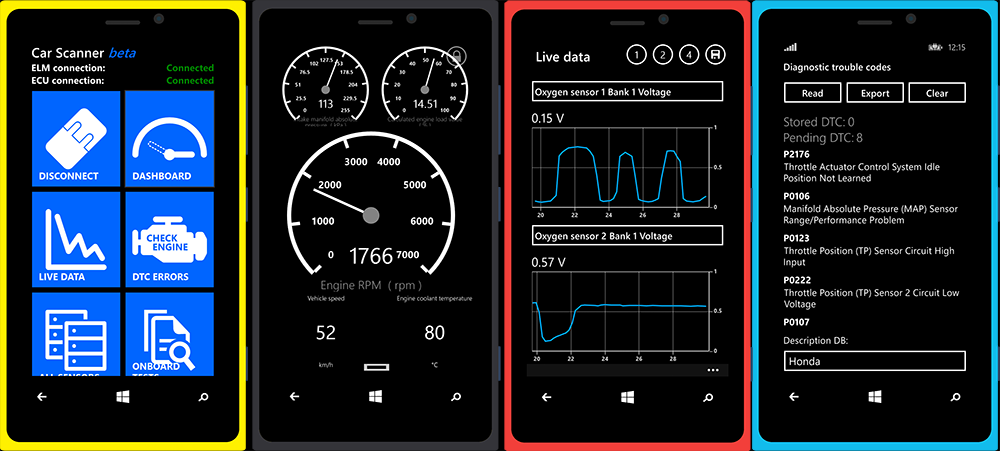Developer Submission: Car Scanner Pro - all in one diagnostic solution for your car
5 min. read
Published on
Read our disclosure page to find out how can you help MSPoweruser sustain the editorial team Read more

Your car’s dashboard is probably home to a speedometer, a tachometer, a fuel gauge, and — if you’re lucky – a coolant temperature gauge. However, your car’s electronic brain (ECU) is actively monitoring dozens of parameters behind the scenes that you, the driver, could find useful. This is where diagnostics hardware and apps like Car Scanner Pro or Car Scanner for Windows/Windows Phone step in, putting all of that data at your fingertips.
What do we need for that?
Apart from the application, you will need an OBD2 ELM327 Bluetooth or WiFi adapter which plugs into your car’s diagnostics socket, and, of course a car, that supports OBD2 standard. You can find one on eBay, Amazon, Aliexpress, Google or Bing using keywords “elm327 bluetooth” or “elm327 wifi”.
Please, note that all cheap adapters – are clones of original ELM327. Some of them works fine, but 100% of clones marked with v.2.1 has lots of bugs.
Some of you thinks, that car diagnostic is just reading trouble codes, but in fact, it’s much more! You can check, how deep is the rabbit hole with Car Scanner Pro, that brings you inside you car’s “brains”.
Firing up Car Scanner Pro brings the user to a home screen where the app’s main functions (Dashboard, Live data, DTC errors, All sensors, Onboard tests, Info, Freeze frame, OBD terminal and Acceleration tests) are presented as tiles.
Dashboard is the heart of the Car Scanner Pro app. Users can swipe between seven “screens” upon which they may place any number of virtual indicators. Indicator types include gauge, chart and digital text readings. These gauges can be set to monitor any of a number of metrics supplied by your car ECU (engine RPM, fuel flow rates, temperatures of coolants, oil, intake air, etc.).
Live data can be used for advanced diagnostics, when you need to focus on one or several sensors readings. In this area they are presented only as charts (user can switch between one, two or four charts). It’s very useful when you want to compare oxygen sensors readings or check how accelerator pedal position affects fuel trim. You can export your Live data session to a CSV file, that you can analyze on PC.
All sensors shows you readings from all sensors at once. It’s very useful to get overall information about your car. Tap on a single sensor and you’ll get in Live data with tapped sensor selected.
Please, note that list of supported sensors in Dashboard, Live data and All sensors is provided by your car ECU. So if you’re not able to see something, it’s not the app – it’s your car ECU doesn’t provide it through OBD2.
DTC errors. We all, well at least, everyone who drives, have felt that second of irrational panic when the “engine fault” light on the dashboard suddenly lights up. It is, of course, recommended that you drop your car off at a service station as soon as possible, as in most cases you have no way to know where exactly the fault lies. Until now – Car Scanner let’s you check DTC errors. It helps to explain error meanings, using different manufacturers database. But don’t get said, if you can’t find your DTC code in built-in database – you can use one of four online databases just from the app. And one more thing – you can clear DTC errors! Please, do that only if you understand, what it means – ECU “forgets” about all errors happened, but it doesn’t fix your car, if there is a malfunction present.
DTCs are divided in 3 groups: stored, pending and permanent. Stored DTC codes are confirmed errors, that happened two or more times, while pending – are errors, that happened just one time during current drive cycle. If it happens again – ECU would consider this code as confirmed and move it to stored or permanent.
Permanent codes tells you about error, that can’t be cleaned without repairing your car.
Freeze frame shows you state of your car, when DTC error was stored. It helps to understand what caused the error. But, note, that most of cars store just one freeze frame, while there could be several DTC codes.
Freeze frame shows you sensor data, captured when DTC error was stored.
Onboard tests. That is a very interesting part, previously available only in professional software. While you driving a car, your ECU constantly doing different tests to check your car health. In this mode you can see results of that tests. But there is a bad thing – just about 10 tests have clear title, defined by OBD2 standard, while all other tests are manufactured defined and car manufacturers concealing their meaning.
Acceleration tests. Here you can measure how fast is your car. You can setup unlimited number of acceleration tests (like 0-20, 0-40, 0-60, 0-80, 0-100, 40-100) and test all of them at a single ride! I have tried acceleration test on my Ford Focus 2.0 AT and it accelerates 0-100 km/h at 10.2 seconds, which is even a little bit faster than 10.7 sec, defined by manufacture 🙂
Onboard tests are done by your car’s ECU to detect malfunctions of different components. In this mode you can check tests statuses (passed or failed).
Please, note that not all cars are compatible with ELM327 and Car Scanner. If you have any troubles, you can always ask developer for help using “Contact developer tile” on main screen.
[gallerify]
[/gallerify]
Being a Universal app, Car Scanner Pro and Car Scanner supports both mobile (Windows Phone 8.1, Windows Mobile 10) and PC/laptop/tablet platforms (Windows 8.1, Windows 10).
[appbox windowsstore 9nblggh5rv45]
[appbox windowsstore 9nblggh5lpx9]






















User forum
2 messages